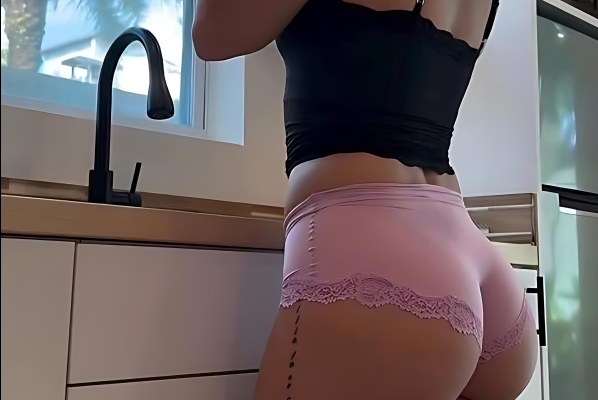🌀 The Art of the Double Take: A Thousand Words on Photos That Trick the Mind
We live in a world saturated with images, but every now and then, a photo comes along that makes you pause—not because it’s shocking, but because it’s confusing. You look once, then again. You tilt your head. You squint. And then you laugh. These are the “dirty mind” photos—images that are completely innocent, yet somehow suggestive. They don’t cross the line; they dance on it.
At the heart of this genre is ambiguity. A shadow falls just right. A pose is caught mid-motion. A sign is poorly placed. And suddenly, your brain fills in the blanks with something far more risqué than reality. It’s not the photo that’s dirty—it’s your interpretation.
📸 Examples That Make You Look Twice
Let’s explore a few iconic examples from the genre:
- The Slide That Isn’t What You Think: A child’s playground slide, photographed from behind, looks suspiciously like something else. But it’s just plastic and gravity—your mind did the rest.
- The Cucumber Conundrum: A perfectly normal vegetable held at an unfortunate angle. It’s a farmer’s market moment turned viral giggle.
- The Father-Son Statue: A sculpture meant to celebrate family bonding ends up looking like a scene from a very different kind of story. It’s all about the positioning.
- The Flute Prodigy: A child playing a musical instrument with such enthusiasm that the photo angle makes it look like… well, not music.
- The Sofa That Suggests Too Much: A piece of furniture with oddly shaped cushions becomes the star of a thousand memes. It’s just upholstery, but your brain disagrees.
These images are harmless, yet hilarious. They invite you to laugh—not at others, but at yourself. At your assumptions. At the way your brain fills in gaps with the most unexpected associations.
🧠 Why Our Minds Go There
The phenomenon behind these photos is rooted in psychology. Our brains are wired to recognize patterns—especially faces and bodies. It’s a survival mechanism. But it also means we’re prone to pareidolia: seeing familiar shapes in random objects.
When a photo triggers this response, it’s not because the image is inappropriate. It’s because our minds are playful. We project meaning onto ambiguity. A tree branch might look like a limb. A shadow might resemble a silhouette. A logo might suggest anatomy. It’s all in the interpretation.
And interpretation is shaped by culture, experience, and mood. What one person sees as funny, another might miss entirely. That’s the beauty of these photos—they’re interactive. They invite you to participate in the illusion.
🎭 The Role of Timing and Perspective
Many of these images are accidental masterpieces. A dog jumping into someone’s lap. A person bending over at just the wrong moment. A sign placed next to a mannequin. These aren’t staged—they’re serendipitous.
Photographers—whether intentional or not—become curators of visual irony. They capture scenes where context is everything. Remove the context, and the image transforms.
This is especially true in advertising. A billboard with a poorly placed slogan. A product label with unfortunate spacing. These moments become viral not because they’re offensive, but because they’re funny. They reveal the gap between intention and perception.
🌍 Cultural Layers and Shared Laughter
Humor is deeply cultural, and so is perception. What looks suggestive in one country might be completely benign in another. A gesture, a pose, a symbol—each carries different meanings across borders.
These photos, then, become a kind of global Rorschach test. They reveal not just how we see, but how we interpret. And interpretation is communal. These images often go viral because they invite comments, captions, and debates. Is that really what it looks like? Or are we just seeing what we want to see?
In this way, they become more than photos—they become conversations. They bridge difference through laughter, reminding us that even in misinterpretation, there’s connection.
🖼️ Legacy of the Look-Twice Genre
This genre isn’t new. Long before memes, artists played with visual ambiguity. Think of M.C. Escher’s impossible staircases or Salvador Dalí’s surreal landscapes. These weren’t suggestive, but they were disorienting. They asked viewers to look again, to question reality.
Today’s “dirty mind” photos are the casual descendants of that tradition. They’re snapshots of everyday life that, through coincidence or cleverness, become visual riddles. And like all good riddles, they invite us to solve them—not with logic, but with laughter.
They also remind us of the importance of context. A photo of three pigs in a pen is just that—until the angle makes it look like something else entirely. A water bottle designed for children is perfectly innocent—until the packaging creates an illusion that makes adults giggle.
These moments are fleeting, but their impact lingers. They become part of our shared visual vocabulary, passed around in group chats, posted on forums, and revisited when we need a smile.
💬 Final Reflection
In the end, these photos are not about dirtiness—they’re about delight. They celebrate the playful side of perception, the joy of ambiguity, and the humor that arises when we see the world not as it is, but as it might be. They ask us to look again, to laugh, and to embrace the quirks of our own minds.
So the next time you see a photo that makes you pause, don’t be embarrassed. Be amused. You’re not seeing something wrong—you’re seeing something wonderfully human.


